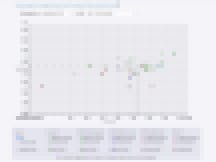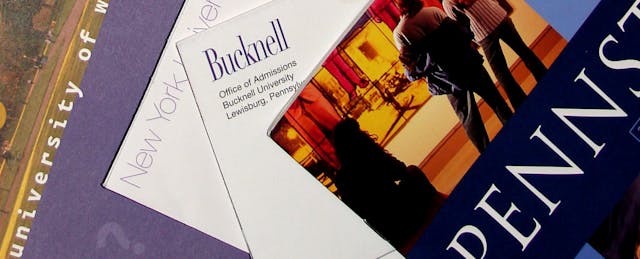For decades, the college-admissions process has been shrouded in mystery. But these days, big data, and a popular college planning tool, are taking much of the guesswork out of applying to college.
That was a major takeaway from Christine Mulhern’s new research on Naviance, a widely-used online college-readiness platform.
Mulhern, a doctoral candidate in Harvard’s Kennedy School of Government, provides evidence that Naviance’s college research and admissions tools are changing where students apply to college, with the “potential to affect higher education on a national scale,” she wrote on Twitter after unveiling the research.
“This research shows this technology has a lot of power and influence” over students’ college decisions, Mulhern tells EdSurge.
According to company officials, Naviance is used by about 40 percent of high schools in the U.S. That reach gives the product an outsized role in the college admissions process, Mulhern adds.
Naviance, a product launched in 2002 by parent company Hobsons, offers K-12 schools a suite of college planning tools, including detailed college profiles, a matching function that pairs students with institutions, and graphs that use schools’ historical data to help students evaluate their acceptance odds.
In her research, Mulhern focuses on that last tool: the scattergram.
Naviance scattergrams show prospective college students how their peers at their high school fared with individual colleges and universities—and helps provide a sense of how they can expect to perform in the admissions process. For each institution, previous applicants’ GPAs are plotted on the y-axis and their ACT or SAT scores appear on the x-axis. Each applicant’s college decision (accepted, rejected, waitlisted) is denoted with a unique color and symbol, collectively depicting the caliber of student who is typically accepted to a given school.

Mulhern’s paper, which is currently under review for an academic journal, examines the college choices of students in an unnamed district in its first three years of using Naviance. The district has 10-15 schools and 4,000 yearly graduates.
After one year using Naviance, the district made its first set of scattergrams available. Each subsequent year, it added new student admissions data. On average, Mulhern writes, students had access to scattergrams for 47 different colleges and universities.
This district set a restriction so that data points for any given college were only displayed if a minimum of five students had applied to that institution in previous years, meaning students would only see scattergrams for those colleges popular with other students at their school.
Based on what Mulhern observed in this district, setting a restriction “definitely pushes students to attend the same colleges as their predecessors,” she says. But that problem lessens over time as more data points are accrued and more colleges appear.
She adds: “This is a limitation, but I think the flip side is that students pay a lot of attention to what’s in Naviance because of their peers. Students care a lot about what their peers are doing.”
Not every district requires a minimum of five applicants for a scattergram, says Kim Oppelt, the director of research at Hobsons. Schools can customize their data points and set minimums anywhere from one to 10 applicants. And if, for example, only one out of six applicants was admitted to a college, and that admitted student was an athletic recruit or had legacy status, schools can choose to denote that in Naviance.
Oppelt cautioned that while scattergrams may be the most high-profile of Naviance’s tools, it is not meant to be evaluated in isolation.
“We look at the scattergrams as one piece of the puzzle,” she says. “If there aren’t a lot of data points in the scattergram, we encourage students to do a holistic search.”
So, how did Naviance change the district Mulhern studied? Students are, on average, 20 percent more likely to apply to a college with a visible scattergram. For in-state public colleges, they’re 53 percent more likely to apply and two times as likely to enroll if the institution’s scattergram is visible. That holds true for students who have similar GPAs and SAT or ACT scores. But the scattergrams also have a positive impact on students from historically underrepresented populations, who are more likely to apply to a college whose admissions information is available in Naviance.
In fact, Mulhern’s findings suggest that Naviance’s tools have the greatest impact on black, Hispanic and low-income students. “Every additional relevant scattergram they see, for an in-state public college, causes a 2.3 percentage point increase in four-year college enrollment,” she writes in the paper.
“The results really support what we’re seeing every day,” says Oppelt. “Naviance is a vital part of the college planning process … We’re seeing Naviance opening doors for students.”
To help support that claim, Oppelt offered two case studies: After adopting the tools, Chicago Public Schools saw two- and four-year college enrollment increase by 26 percent, and Arizona’s Flagstaff High School noted a nearly 13 percent spike in its college acceptance rate.
Whittled down, the research shows that more information leads to more applications, and that students rely on their peers’ judgment in helping them determine the right fit for college.
But there are some caveats. Mulhern found that when Naviance was introduced to the district she evaluated, fewer students applied to so-called reach colleges, where students are less certain of their admissions prospects. Similarly, more apply to and enroll in “safety” institutions, where students feel more confident they will receive an acceptance.
Additionally, when high schools create minimums of five or 10 applicants, only the popular institutions appear on the scattergram. Based on what Mulhern found about students applying to colleges with visible scattergrams, it’s reasonable to deduce that the diversity of colleges students apply to could decrease with Naviance.
“The overall takeaway,” Mulhern says, “is that students are paying attention to this.” Naviance, which provides its tools to districts for about $10 per student, “has found a way to do this that other technology companies have not done, or not as successfully.”


